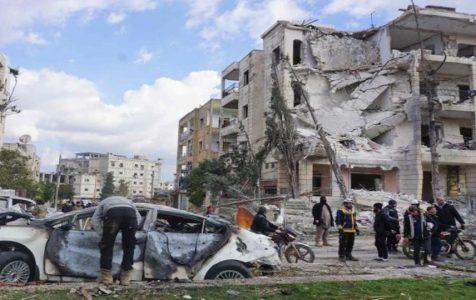
Rise of Al-Qaeda unit in Syria poses a new challenge
During his September summit with Russian President Vladimir Putin, Turkish President Recep Tayyip Erdogan promised to cleanse the Syrian north-west of Hayat Tahrir Al Sham (HTS), the Al Qaida branch in Syria, formerly known as Jabhat Al Nusra, by mid-October 2018. That deadline has passed, and so have its extensions, yet instead of shrinking in size, HTS seems to have expanded both horizontally and vertically, over-running 75 per cent of territory still held by the armed Syrian opposition.
Their influence now bestrides parts of the three governorates of Idlib, Aleppo and Hama. They recently entered Sahl Al Ghab, a fertile valley in the countryside of Aleppo, in addition to Shahshabo Mountain and Barakat, a strategic mountain in the western countryside of Aleppo, overlooking Daret Izza, a town located 30km north-west of Aleppo, now also in the hands of HTS. A series of other towns collapsed to HTS in recent weeks like Tall Manas, Al Gadfah, Jarjanaz and Al Hiraki — all in the vicinity of Maaret Al Nouman, part of the Idlib governorate.
Instead of waging an uphill battle against HTS, Erdogan let them expand, then evacuated two of his most powerful groups, Ahrar Al Sham and the Zinki Brigade, from HTS territory.
His fighters have been relocated to the Syrian north, where they will come in handy for the Turkish leader as he plans to overrun remains of Kurdish militias along his border with Syria.
Why waste manpower on a province like Idlib, which he realises he cannot hold onto forever and will have to ultimately surrender to the Russians, given it lies within Russia’s sphere of influence? With Erdogan wriggling out of the confrontation, the Syrians and Russians are preparing for an all-out offensive on Idlib, saying that they will do the job themselves, regardless of the battle’s death toll and how many refugees it will produce.
From their positions in the countryside of Hama, the Russian and Syrian armies have already started an aerial campaign against Idlib, promising a ground invasion by next spring.
When the Russians entered the Syrian battlefield back in September 2015, HTS was given secondary priority, seen as the lesser of two evils than Daesh [the self-proclaimed Islamic State of Iraq and the Levant].
As they chased Daesh fighters out of cities like Palmyra, while the Americans were bombing them in Raqqa, HTS watched from a distance, learning from all of Daesh’s self-proclaimed caliph Abu Bakr Al Baghdadi’s mistakes. One of them, no doubt, was biting off more than he could chew, trying to occupy territory on all four corners of Syria and Iraq, while sending arms and fighters to sister groups in Lebanon, Libya, Egypt and Nigeria.
That stretched him thin, consuming Daesh’s financial and military resources, while diverting the attention of its fighters from their original battles in the deserts of Syria and Iraq. HTS’ elimination is now proving far more complicated than what the Russians had expected three years ago. For starters, HTS is almost exclusively composed of Syrian fighters, unlike Daesh which was a colourful assortment of foreign fighters from across the Arab world, Asia, Europe and of course Iraq. Local Syrians made up no more than 10-15 per cent of Daesh ranks. The foreign fighters were aliens fighting on rugged — and very unfamiliar — territory. They suffered from a crippling language barrier, topped with little background on the cities and towns that fell under their control in 2014-2015.
HTS knows the terrain inside out and are deeply embedded in the areas that they overran since last January. Their boss, Abu Mohammad Al Golani, is a Syrian, surrounded by Syrian advisers and Syrian bodyguards, unlike Al Baghdadi, an Iraqi fighting in Syria. While Abu Bakr continues to live in hiding, from one cave to another, Golani’s headquarters are well known. Just this month he moved from Sarmada on the border with Turkey to Harem, 55km west of Aleppo. Surrounded by loyal Syrians, he is less fearful of assassination — or a coup — than Abu Bakr ever was.
Golani’s campaign has repeatedly been blessed by Ayman Al Zawahiri, the current head of Al Qaida and former comrade of none other than Osama Bin Laden. This gives him a global Al Qaida network that he can tap into whenever in financial or military need, two things that Abu Bakr Al Baghdadi never had.
Additionally, HTS has evolved since it premiered on the Syrian battlefield back in 2012. It learnt from its previous mistakes in Iraq and from those of Daesh in Syria. It has already undergone two major facelifts in 2016-2017, aimed at appealing to both an extremist and non-extremist audience, changing its name first to Jabhat Fateh Al Sham and then to the current Hayat Tahrir Al Sham.
Defeating HTS will not be easy and taking down Golani will soon prove much harder than Baghdadi.
Source: Gulf News





